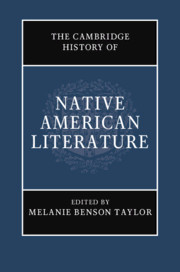Book contents
- The Cambridge History of Native American Literature
- The Cambridge History of Native American Literature
- Copyright page
- Contents
- Figures
- Contributors
- Introduction: What Was Native American Literature?
- Part I Traces and Removals (Pre-1870s)
- Part II Assimilation and Modernity (1879–1967)
- Part III Native American Renaissance (Post-1960s)
- Part IV Visions and Revisions: 21st-Century Prospects
- Index
- References
Introduction: What Was Native American Literature?
Published online by Cambridge University Press: 18 September 2020
- The Cambridge History of Native American Literature
- The Cambridge History of Native American Literature
- Copyright page
- Contents
- Figures
- Contributors
- Introduction: What Was Native American Literature?
- Part I Traces and Removals (Pre-1870s)
- Part II Assimilation and Modernity (1879–1967)
- Part III Native American Renaissance (Post-1960s)
- Part IV Visions and Revisions: 21st-Century Prospects
- Index
- References
Summary
As both the record of and rationale for a settler construct, “Native American literature” has always been uniquely embattled: a body of production marked by particularly divergent opinions about what constitutes “authenticity,” sovereignty, and even literature. As such, its texts announce a culture beset by paradox: simultaneously primordial and postmodern; oral and inscribed; outmoded and novel; quixotic and quotidian. Above all, its texts are a site of political struggle, shifting to meet expectations both external and internal. This Introduction sets out the plural, capricious, and contested character of both Indigenous texts and our habits of evaluating them.
Keywords
- Type
- Chapter
- Information
- The Cambridge History of Native American Literature , pp. 1 - 14Publisher: Cambridge University PressPrint publication year: 2020
References
- 1
- Cited by



